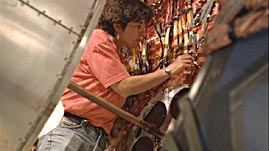Models showing the structure of atoms have changed a great deal since the first one -- a simple, undifferentiated sphere -- was proposed in the early 1800s. In today's atomic model, a "cloud" of negatively charged electrons orbits around a small, dense nucleus of positively charged protons and neutral neutrons.
At one time, physicists thought that protons, neutrons, and electrons were fundamental particles, meaning that they are not made of anything smaller. However, since the 1950s, more and more evidence has been discovered for the existence of even smaller particles. For example, physicists now know that protons and neutrons, the particles that make up an atom's nucleus, are built from six types of particles, collectively called quarks. In addition, they have found evidence for about a dozen other types of elementary particles, some associated with matter and others with the forces that act on matter. Many physicists surmise that all matter and forces are comprised of these 19 different types of particles.
One of the most important tools in the search for the universe's smallest particles is the accelerator. These devices use electric and magnetic forces to accelerate particles until they move at almost the speed of light and carry a huge amount of energy. Their paths are then focused so that they collide with other such particles. Devices called particle detectors, which surround the acceleration chamber, record the results of the particle collisions. By analyzing the behavior of the particles when they collide, the types of particles that result, and the momentum and energy of the new particles, physicists can piece together an understanding of the physical properties of each type of particle.
The particle detector at the Fermi National Accelerator Laboratory near Chicago, Illinois, is one such detector. While not a microscope, particle physicists use the detector to indirectly "see" the particles involved in the accelerator's collisions. In fact, the detector allows physicists to analyze data from hundreds of thousands of collisions each second, a capability that resulted in the discovery of the elusive top quark in 1995.

 Loading Standards
Loading Standards Teachers' Domain is proud to be a Pathways portal to the National Science Digital Library.
Teachers' Domain is proud to be a Pathways portal to the National Science Digital Library.
